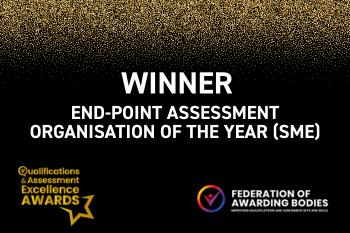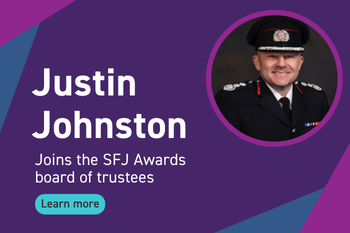The End-Point Assessment (EPA) is a pivotal part of any apprenticeship in England . The EPA is the final stage of an apprenticeship, and it is an impartial assessment, carried out by a regulated independent body, such as SFJ Awards . EPAs ascertain whether an apprentice has gained the knowledge, skills, and behaviours required by the apprenticeship standard.
The type of assessments used in the EPA itself can vary from standard to standard. The assessments are individually designed for each apprenticeship standard by employers from across the sector. EPAs are then conducted by independent bodies known as End-Point Assessment Organisations (EPAOs).
What different types of assessment could be involved in an EPA?
Here are a few of the most common assessments you can expect to see. This list is not exhaustive, and there are many other methods of assessment used in EPAs. Apprentices will need to complete at least two of these assessment methods to pass their EPA.
Jump to:
Multiple choice or written tests
Multiple choice tests involve a set of questions where individuals need to select the correct response from a range of possible answers. This type of assessment method ensures the competence of the apprentice by making sure they know key information and standards and can select the appropriate responses to a given scenario. Multiple choice questions will sit within a suite of different assessments to ensure the competence of the apprentice. Written tests can be conducted in a similar way to multiple choice tests, but they often include more open-ended, essay style questions, with some short-answer or problem-solving tasks too. Written tests often require a deeper level of understanding than multiple choice as they require the apprentice to articulate their knowledge, explain concepts and demonstrate critical thinking.
Both multiple choice or written tests can be conducted in an assessment facility on paper or remotely using online assessment software, such as the system used by SFJ Awards, Rogo. However, both types of assessment could be seen as less accessible to individuals who struggle with written exams. Adjustments to support those who have difficulty with reading and writing can be made on a case-by-case basis.
Professional discussion
A professional discussion is a planned, in-depth, two-way conversation between the assessor and the apprentice. It is an effective way of holistically assessing understanding and knowledge.
Professional discussions can be conducted face-to-face or remotely, making them an inclusive assessment method and questions are usually based on evidence provided in an underpinning portfolio , suiting those who had difficulty with reading or writing more than a traditional written examination.
Practical assessment
A practical assessment can be used in the EPA where apprentices need to demonstrate their skills and competencies through real-world tasks or simulations relevant to their occupational role.
This type of assessment method is particularly useful for apprenticeship standards where the knowledge, skills, and behaviours the apprentice has learnt throughout the apprenticeship is difficult to fully assess or recreate through non-practical methods, such as knowledge tests.
For the Operational Firefighter apprenticeship, for example, the practical assessment involves a whole day assessment (up to 6 hours) split into three tasks with questions:
- Search and rescue with a structure, e.g. fire training building.
- Extrication of casualty from a situation of entrapment.
- Deal with a small spillage of hazardous material.
The types of situations which need to be assessed for this apprenticeship standard (in order to fully understand the apprentice’s level of competence) are all practical exercises. So, in this case, a practical assessment is the best form of assessment to use, in combination with a multiple-choice knowledge test and a professional discussion.
Presentation
Where a presentation is used as a method of assessment in an EPA, it will be led by the apprentice, following a pre-agreed outline brief. Usually, it will include a short presentation with slides, notes, and handouts. This form of assessment gives the apprentice an opportunity to take ownership and control of the assessment.
The ability to present well may be an important skill in their chosen occupation, so this assessment method not only assesses the apprentice’s knowledge of their subject but also their skills when presenting under pressure.
Project
This type of assessment requires apprentices to undertake a project that is relevant to their job role and industry, demonstrating their knowledge and skills in a real-world context. Projects for EPA can be lengthy and substantial pieces of work requiring research. As part of the assessment, apprentices may need to present the results of their project and answer a set of questions from the Independent Assessor.
The EPA for the Youth Justice Practitioner apprenticeship standard includes a project with presentation and questioning. This assessment includes two components:
- Component 1: Complete a 5,000-word project on an agreed key theme.
The typical duration of the project should be a maximum of 8 weeks from the gateway. - Component 2: Presentation with questioning.
Present the results of the project work to colleagues and/or stakeholders.20-minute presentation then the Independent Assessor will ask a minimum of 10 questions (40 minutes).
EPA is a critical and comprehensive measure of an apprentice’s readiness to transition into their professional role. With a variety of assessment types, EPAs are designed to rigorously evaluate the full range of knowledge, skills, and behaviours required by the apprenticeship standard. Each method serves a unique purpose, ensuring that all aspects of the apprentice’s competence are thoroughly tested. As apprentices prepare for their EPAs, understanding these different types of assessments will help them showcase their abilities and successfully complete their apprenticeship journey.





